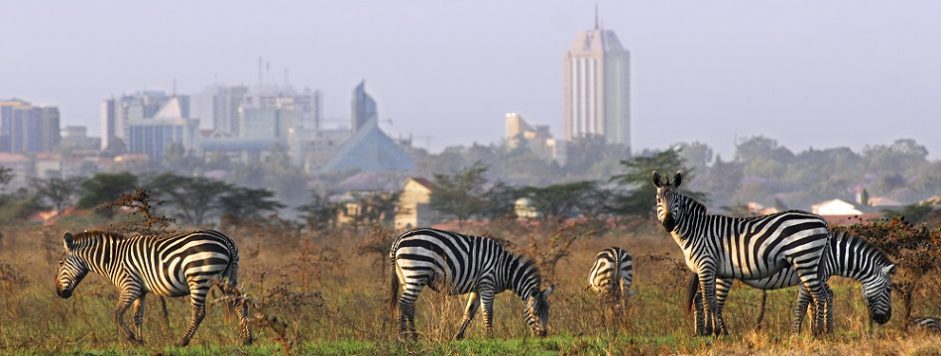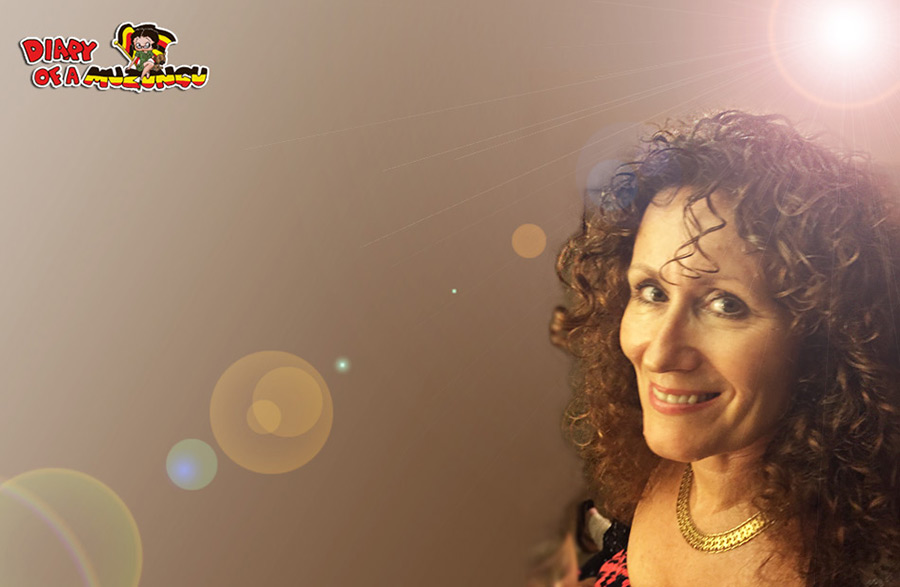
A city safari in Nairobi National Park. An early morning game drive to match any safari in the bush!
It seemed weird to leave our four-star city hotel and drive through commuter traffic for an early morning safari. Usually, it’s a question of stumbling out of a tent into the Bush… [Note to self: next time, don’t miss the safari vehicle when it leaves the hotel!] If you’ve seen the incongruous-looking photographs of wildlife in front of a modern urban background, then you may know I’m talking about Nairobi National Park (which is actually in Kenya’s capital, making it very accessible for weekend or business visitors).

A flight with Safarilink shows the proximity of Nairobi National Park to Kenya’s capital
Despite many wonderful safari experiences in Uganda, notably while working for the Uganda Conservation Foundation, this was my first safari in Nairobi National Park and my first time to see White Rhino, Thomson’s Gazelle, Wildebeest, Eland, Ostrich and Reticulated Giraffe in the wild. (Uganda has Eland but they are very shy, and Ostrich are in the remote northeastern park of Kidepo).
Nairobi National Park is a pocket-handkerchief-sized 117 km² and the animal diversity is pretty amazing! The park is home to to 100s of species – elephant being one of the few that are missing. You’ll have to go to Maasai Mara, Amboseli or Tsavo – among many other conservancies and National Parks – to see elephants.

Aerial view of Nairobi National Park in the rain
Immediately we entered the park, there were the familiar smells of damp vegetation and animal manure. It smells like a National Park, it sounds like a National Park, and the variety of wildlife we encountered was soon to demonstrate that we really were in a National Park, despite it being surrounded on three sides by human development. Small aircraft flying overhead gave the Park another dimension. (You might say Nairobi National Park is boxed in from the air too).

‘Pemba’ the Swahili for warthog, Nairobi National Park. Photo Kenya Tourist Board / Magical Kenya
We passed the site where the Kenya Wildlife Service made history and burned the stockpile of confiscated elephant ivory. Kenya has taken bold steps to tackle poaching. It is well documented that the sale of legally gotten ivory (through the natural death of an elephant, for example) has stimulated unprecedented demand for ivory in China and fuelled the catastrophic levels of ivory poaching across Africa.

“If no elephant ever complained about the weight of their tusks, why take them off?” #WorthMoreAlive Kenya Wildlife Service

Click on this image to read why “Why it makes sense to burn #elephant and #rhino #ivory stockpiles…” #worthmorealive
The destruction of ivory, sometimes by burning, but these days by crushing, is the only answer. The temptation to steal confiscated ivory (valued at several thousand US dollars per kilo) is too much for many, and the penalties for being caught not harsh enough.
Early morning, our driver Anthony communicated in Kiswahili by radio with the other drivers in our safari convoy and announced that another driver had just spotted a pride of eleven lions ahead of us. (You can imagine our excitement!) We paused above a wooded ravine but it seemed the big cats had gone to cover. They were (understandably) not in a rush to come out and be gawped at by us lot!

RIP Mohawk the lion, seen here in his natural habitat: the sad reality is that lions which leave the safety of Nairobi National Park will be lost in the surrounding city and killed. Photo Will Knocker
Instead of seeing lions, we were rewarded with seeing three White Rhino.
Nairobi National Park has a population of 27 White Rhino. It was wonderful to see them in the wild! (To date, I’ve only seen White Rhino at Ziwa Rhino Sanctuary in Uganda. Uganda’s own population of Black and White Rhino are extinct).

Look carefully and you will spot three of Nairobi National Park’s white rhinos !
[Note to self: wear something warm if you’re going on an early morning game drive when the safari vehicle pop-up roof is open!]

An ostrich and a wildebeest. Ostrich are much bigger than I had imagined them to be. Uglier too! We saw five of these big birds in Nairobi National Park

Did you know… a group of zebras are called a DAZZLE? Common zebra grazed one side of the dirt track

My most memorable moment of our Nairobi safari was watching the single, elegant giraffe walking slowly down the track towards us
It peered at us through the open roof as it brushed the side of the van. With gasps of excitement as the giraffe walked within inches of us, not one of us professional travel writers, bloggers and photographers managed to take a decent photograph!

[Note to self: do read the manual before you use your new camera for the first time!]
Wildlife is under immense pressure by human encroachment. Nowhere demonstrates this better than Nairobi National Park: human development on three sides of the park; planes flying overhead; the need to install water systems for the wildlife because the human populations are preventing water reaching the park. Controversially, infrastructure projects such as the Standard Gauge Railway have also been designed to go through the park. I’m a big fan of train travel – as you may remember from my trip on the Lunatic Express from Nairobi to Mombasa but I believe that one day Kenyans will regret the decision to let the train route go through the park (many are bitterly against it). Why can’t the SGR and the bypass be rerouted around the outside of the park? Why can’t underpasses be built? The deal has been done. We just pray disturbance of animals is kept to a minimum.
Have you been on safari in Nairobi National Park?
I really enjoyed our early morning game drive and saw many species I had never seen before. A safari in Nairobi National Park is a fantastic day out if you have limited time in the capital. It’s a delightful way for people who live in Nairobi to (re)connect with their incredible natural heritage too.

Vervet Monkey waiting for me to put something in the bin…. so he can quickly remove it again! Near the hippo pools, Nairobi National Park
Where to find more info on safaris in Nairobi National Park
I think that if I lived in Nairobi, I would volunteer with Friends of Nairobi National Park. Check out their web site, plus the management’s own Nairobi National Park website and the Kenya Wildlife Service’s Nairobi National Park and Nairobi Safari Walk pages.
Wildlife fans will have to visit the Nairobi Animal Orphanage too! (It’s located in Nairobi National Park so you can visit after your game drive).
If you enjoyed my blog about Nairobi National Park, feel free to share it!





























Nice to know you enjoy your morning excursion at NNP
It was fantastic. So many ‘firsts’ – my first urban safari, first sighting of wild ostrich, first time I missed the safari vehicle that was taking us on our game drive!
your photos and life experiences are magnificant to say the least..i am so jealous of what you see just on a daily basis. it it breathtakingly beautiful all the animals. i pray and hope they will be there for many years to come but i fear they won’t. man is too greedy and selfish and i am devestated just in the animals especially rhinos that are extinct in my lifetime. i can’t bear it sometimes to think at how many more species will be gone before i die. please african people save your animals do whatever it takes. please. no poaching. when the animals are gone, they are gone….
Kenyans lead the way in wildlife conservation and are battling hard to protect their incredible diversity but we need to keep the pressure on. Growing human populations and climate change are issues that just keep growing. Ref poaching, it’s the people with money who fund the poaching that we need to stop. We need to close all the ivory markets globally too. The African who actually kills the animals is usually getting very little money and runs the biggest risk of all. The greed is on the side of the syndicates who fund this activity and the (uneducated) consumers who – for the most part – aren’t aware of how ivory is being gotten.
It is wonderful to see these pictures and it was a superb experience as I have seen in this post..
Visiting game reserves has been my routine habit this year. It good to make sure that wildlife is protected for future generations to have the same experience too.
On June 10th 2020, Kenya Wildlife Service held an online discussion on the revised draft for Nairobi National Park Management Plan 2020 – 2030.
Nairobi National Park is home to over 100 species of mammals and 400 species of birds. It has over 200,000 visitors a year; however, some believe these numbers are low and that the visitor experience can be improved. Visitors surveyed by Kenya Wildlife Service complain about lack of interpretive signage, long queues and lack of catering facilities. Others talk of poor wildlife sightings, dusty roads during the dry season (and muddy roads during the rains).
Prof Charles Musyoki discussed community relations. KWS plan to invest in infrastructure such as a footbridge and an ampitheatre for cultural performances for visitors. They aired the wish to work more closely with the neighbouring conservancy.
Dr Patrick Omondi highlighted numerous interventions including migratory issues, Maasai giraffe conservation, breeding of white rhino to restock different areas of the country, lion conservation, the supplementing of salt lakes, the need to restore buffer zones to reduce invasive species, the viability of wildlife corridors, the control of water use and pollution, climate change and zooonotic disease monitoring (especially the proximity of domestic animals).
The CS of KWS Brig (Rtd) John Waweru discussed Kenya Wildlife Conservancies Association https://kwcakenya.com/ a partnership between KWS and conservancies
According to KWS “the 10 year plan has been developed through a participatory planning process involving a cross section of Nairobi National Park stakeholders.” This process all looked very promising on the screen (but meeting participants were quick to complain that community participation in the process had not happened).
According to Paula Kahumbu “Nairobi Park is an asset for Kenyans. KWS is the custodian but the views of people seem to be downplayed despite promises from the CS that the engagement with people will be transformative. Given that this plan is already 10 years late, why is the plan being rushed when it’s impossible to have proper consultations. It is the cause of great public concern and upset. There is so much to be gained by doing this properly and in good faith. The rush at this time is causing much distrust.”
Facilitator Doreen reminded us that “park management plans are supposed to be living documents” and that the community has “a strong desire to be part of that process.”
According to KWS “the Nairobi National Park Management Plan has five management programmes: ecological management, tourism development and management, community partnership and education, security management, park operations management. The purpose of Nairobi National Park is to protect diverse critical habitats, especially highland dry forest, savanna and wetlands, and their associated species of concern such as black and white rhinos and lions for the benefit of present and future generations.”
Discussions are ongoing.
“Nairobi National Park increased to 78,000 acres.” 25th September 2020.